BAFA © 2010. All material here is copyrighted. See conditions above. |
Alexis Hunter painter, U.K. / New Zealand
|
 Alexis Hunter in China, 1997.
Alexis Hunter in China, 1997. |
Born in New Zealand and arriving in England in 1972, she joined the first groups of the Feminist Art Movement, going on to make some of the most radical work of the 1970's in the U.K., the "Approaches to Fear" series.
These photographic sequences were seen as paradigmatic of the change in women's lives and were shown by the British Council in all the major U.K. museums, and internationally.
Since 1981, Alexis Hunter has shown figurative paintings, exhibiting regularly in London, where she lives, and in Wellington and Auckland (New Zealand). She has had solo exhibitions in Europe and New York and has participated in numerous group exhibitions internationally.
|
She recently curated an exhibition of eight leading women figurative artists from Britain alongside eight from China. These included, along with herself, Paula Rego, Alison Watt and Jenny Saville. One of the Chinese artists, Deng Lin, is the daughter of the former premier, Deng Xiaoping.
I begin an idea by working very quickly with acrylic on paper, and call these ‘automatic’ or ‘trigger’ drawings and paintings to start off a series. I know that you cannot really do automatic paintings - the idea must come from somewhere - but it does help me to select ideas that come from a lot of different sources that are mostly not visual.
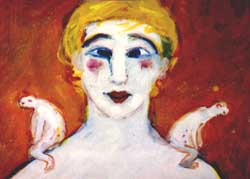
Conscious Thoughts, 1996,
acrylic on paper
| |
To get into the right sort of mood involves meditation, looking at very disparate sources such as in newspapers or on TV, or listening to snatches of conversations. It involves continually changing things, turning them upside down and trying to use different parts of the consciousness.
From 1983 I started using Chimeras (Beings of the Emotions), a medieval concept of good and evil in which animals represent human emotions, though I also incorporated human bodies with animal heads and vice versa. Much of what was called Neo-Expressionism in the early 80s was about the loss of faith and spiritual identity. My work was then a search for personal conviction in the morass of greed and power.
The Passionate Instinct series is about the frustration and sterility of ambition. The creatures are coupling aggressively, but cannot create as they have mutated into different species.
The painting Struggle between Ambition and Desire (1984) asks the question: what are these conflicts for women artists? The ambition to make something important to other people, yet to be loved for oneself; but always having to make compromises each way.
|
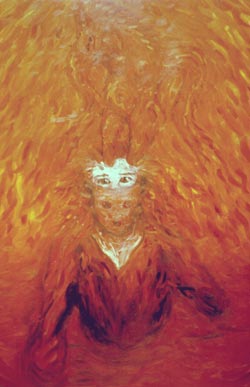
Rivers of the Moon, 1985,
oil on canvas, collection: Auckland City Art Gallery, N.Z.
|
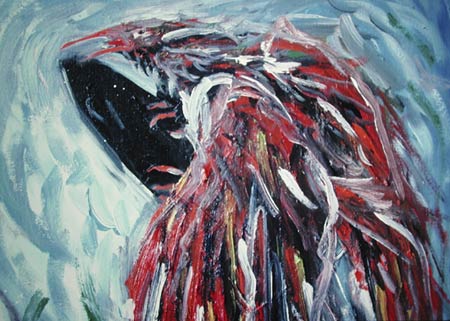 The Passionate Instincts Series (War and Nature), YEAR?
The Passionate Instincts Series (War and Nature), YEAR?
Oil on canvas, 25 x 30 inches. The Wallace Collection, New Zealand.
| The move to a more descriptive style in the Landscapes of the Heart series (1986) was motivated by a period of travelling and looking at other places, turning outward rather than inward. Because they’re less self-expressive, the style changed and became more meditative and controlled. The landscapes are a natural progression from the Passionate Instincts series. The landscape becomes more dominant and specific rather than imagined; for example, Tahiti, Mexico, New Zealand.

Sydney, 1994
Oil on canvas.
|
In the winter of 1986 I moved into more imaginary vistas, making up my own creation myths as in Creation (1987, Collection: Te Papa National Museum of New Zealand). This painting started as a landscape with a river of blood, but people unfortunately thought it was about death, rather than the beginning of life. Later I changed the red into blue and little plants appeared and eventually human faces grew out of these plants. This example shows how a painting can move out of a concept into an unconscious journey of imaging.
In 1997 I have started a series of oil paintings that were an extension of the Trigger Series . (These images came from idiosyncratic thoughts about how people think, such as the painting
Fear of the Intellectual Wife (Collection, New Hall, Cambridge, U.K.).) In the new work the narrative is bound within the same figure, instead of two figures in conflict. In so doing the subject becomes dislocated and mutated into that which defines its (hers, his) mental state. Exploding heads, baying dog growths, sexual self-obsession express the complexity of emotions denied.
|
These latest paintings link up to my drawing practice in their immediacy and humorous irony, which had previously been prevented from seeping into my oil painting, as they were aspects of my past I’ve been reluctant to expose. My drawings express a heightened sense of the ridiculous, which comes from my suburban New Zealand background.
Whether that originates from aspects of the character a person possesses or the sense of difference that comes from being first-generation, with immigrant parents, I couldn’t say. Being an identical twin didn’t help this sense of otherness. People seemed to be confused and annoyed they couldn’t tell us apart, and felt that there was something malevolent in us that prevented them from doing so.
Our excitable imaginations were fuelled by the bizarre behaviour of the people around us. To give you an example: there was an elderly woman living up the road who was known in our family as "That-Woman-Who-Murdered-Her-Husband". In fact she was a Christian Scientist, and had refused permission for her dying husband to have a blood transfusion with inevitable but natural results. She owned a very large, black bull. One afternoon it ran down the road and into our front garden. Mother was very proud of this garden, being the hub of her identity as an Australian. Instead of roses and concrete paths, it was planted out with Australian native flora and proper trees.
|
 Trigger Painting, 1989
Trigger Painting, 1989
Oil on canvas.
|
On the appearance of the bull, our mother, who was short and fat, ran out and started to beat the bull’s head with a rolled-up magazine. The tall and thin Woman-Who-Murdered-Her-Husband appeared in a long red flannelette dressing gown, and proceeded to pull the bull’s tail. The confused animal turned around and around, with the two hysterical women hanging onto each end. Peeking through the venetian blinds, I felt unwilling to participate, with the accompanying guilt that ensures fixation of the memory as a child. Colour is fixed indelibly and the bright hard green of the bullock-grass, cereleum blue sky, orange and pinks of the trampled flowers are used in the new work. The Woman-Who-Murdered-Her-Husband had her revenge by inviting us twins into her gloomy kitchen and feeding us ice-cubes in shiny brown bowls, to be eaten with a knife. After chasing the ice around the bowls politely for what seemed like ages, we co-ordinated up a visualisation of the bull in the bedroom, dressed in the red dressing gown, which gave us the excuse to flee screaming out of the house.
|
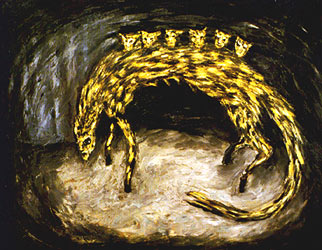 Camden Town Series (mask), 1989, Oil on canvas.
Camden Town Series (mask), 1989, Oil on canvas.
|
It needed a bizarre imagination to cope with the hypocrisy of society in those days. People expected us to treat them as logical beings, but patently they were not. In those days a child had to treat all adults with Victorian deference and not question any behaviour, however odd or perverted. Looking back, it was a privileged childhood in some ways - the access to the wonderful subtropical ‘bush’, elaborate ferns, rate creepers, hidden black streams under the giant Kauri trees - such a contrast to the stiffly clipped lawns that surrounded the clapboard houses heavy with mean gossip, biting into the alien forest with its quiet melancholy. It was something to do with survival to be madder and naughtier than everybody else; then you were not continually surprised or disconcerted and therefore disadvantaged.
|
Fine Art was something that seemed to threaten the status quo. The reproductions of Leger and Picasso were turned to the wall in our house if anyone visited, ‘because people don’t like modern art’. It took me a long time to realise that these artists were members of the Communist Party. Our father would hiss, "Religion is the Opiate of the People" before the regular drive to the Presbyterian Sunday School. When trying to comprehend hypocrisy it seemed easier to reach an understanding by presuming everything was make - believe, a joke.
There must be an element of play in art-making that connects to a pleasurable curiosity about life. Even in my most serious work, in the conceptual socio-political narrative sequences of the
1970s, there is an effort to retain this core of innocence.
|
 In Control, 1998, Ink on paper.
In Control, 1998, Ink on paper.
|
In the 1981 Male Myths series, I questioned the moral basis of Greek mythology in visual art and circumvented it with a certain amount of humour to hide the didactic
motivation of exposing its patriarchal basis. Judeo-Christian mythology was questioned as well, especially the relationship between Eve and the Snake in the Garden of Eden. This work led me to make up a new mythology, beings representing different aspects of psychology and the inherent conflicts of the modern world without a dominant religious dogma (Conflicts of the Psyche, 1984).
|
 Chimerae, 1998, Ink on paper.
Chimerae, 1998, Ink on paper.
|
During the last decade I have felt the necessity to return to the basics of constructing a figurative painting, and so have done a lot drawing from life and experiments in painting, technique, as well as researching the psychology of painting itself. Rather unfashionable in the contemporary art market at present, but an artist has their own journey and must follow it regardless. The culmination of this structural work has come out as complex psychological subjects painted in a simple, confident manner with a tight formal structural base. I have also kept the significant figure centrally in the image to stand as a symbolic icon as in religious art.
As Europeans, we have lost a lot of our cultural inheritance through the reformations of the Church of England. The imaginative painting in illuminated manuscripts, ceiling bosses and the ornament of medieval times and earlier left to us from the past are only faint examples of what we have lost. There is a humanism in the figuration of Celtic mythology, both in England and in Northern France, that seems to be more evocative of the character of the British than the imposition of the ideals of the ancient Greeks and the Italian Renaissance. This iconography, which exposes the flaws of human nature with wit, is carried into the guild tattoos and then into the tattoo imagery of the underworld in modern times. The imagery in my work has come full circle from the Photo-realist Object Series 1974-5 (Collection Auckland City Gallery) of sections of male bodies decorated with tattoos, to the use of Western European tattoo symbolism in the present work.
Excerpts from Arts Dialogue, December 1998.
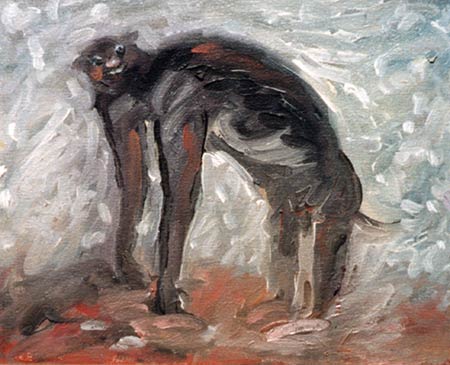
See more work at: www.alexishunter.co.uk
|
- Paintings: The Rescuer & The Rivers of the Moon Arts Dialogue, February 2001
- Illustration: In Control, 1998, Arts Dialogue, February 2000
- Artist Profile: Arts Dialogue, December 1998
- Illustration Camden Town Series (mask): Arts Dialogue, March 1998
|

Arts Dialogue, Dintel 20, NL 7333 MC, Apeldoorn, The Netherlands
email: bafa@bahai-library.com
|
|
 Alexis Hunter in China, 1997.
Alexis Hunter in China, 1997.

 The Passionate Instincts Series (War and Nature), YEAR?
The Passionate Instincts Series (War and Nature), YEAR?
 Trigger Painting, 1989
Trigger Painting, 1989
 Camden Town Series (mask), 1989, Oil on canvas.
Camden Town Series (mask), 1989, Oil on canvas.
 In Control, 1998, Ink on paper.
In Control, 1998, Ink on paper.
 Chimerae, 1998, Ink on paper.
Chimerae, 1998, Ink on paper.

